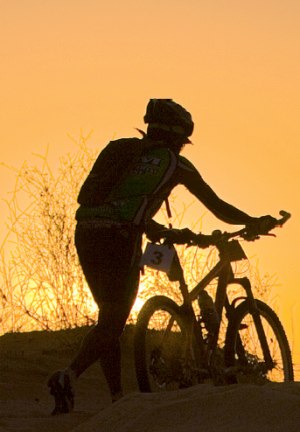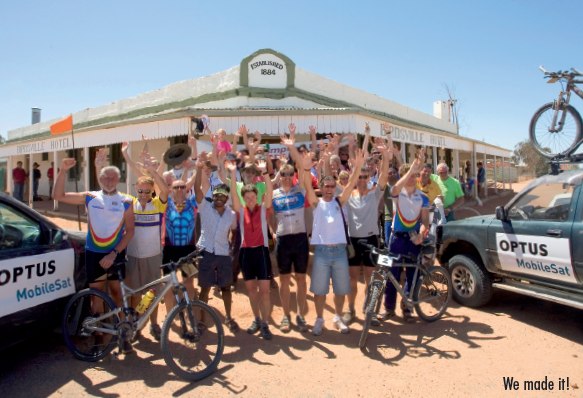Desert Challenge
Every year in late September or early October for the last 19 years, the Simpson Desert has issued a challenge to cyclists from all over Australia and afar.
A challenge to cross it from one side to the other—not a mere 24 hour challenge, not a challenge of speed or steep descents; but a challenge of endurance and determination against an insidious and unpredictable foe that moves and changes from year to year and frequently from day to day. The Simpson Desert Cycle Challenge is a five day 581km enduro event – an event of extremes - like extreme remoteness. You can’t just grab a flight to the nearest city and then a limo to the start line. There are no plush hotels, no bellboy, no concierge and no beds. It’s all about camping out—be it in a tent, swag or on a bed-roll.
The Challenge start line is at least two days travel from any Australian capital city—perhaps more. Those days are just the start because there is a lot of preparation required. You need support crew, a well prepared 4WD vehicle, camping equipment, food and water,

to name just a few.
While you’re on The Challenge you need to be almost entirely self-sufficient and simply getting to the start line is just part of The Challenge. This year, Team Tasmania had a problem that resulted in their support crew falling apart a few days prior to departure. Amazingly rider Andre Gavlik managed to enlist his landscaper Don Williams and his son Jay in a borrowed Hilux dual-cab ute and got there, but only just.
Heinz von Holzen and his support crew Mike Fewster and Suzette Watkins had a power steering failure on the way, they had to backtrack a few hundred kilometres down the Oodnadatta Track to Coober Pedy and wait for a business to open on Monday morning for a repair. The Challenge means preparation—not that you can ever be fully prepared. You never know what The Simpson Desert will throw at you.
"Firm looking sand is often so soft that your front tyre gets caught unexpectedly sending you over the bars into the fine prickles alongside the track."

Critical Care
Only one thing is considered more important than caring for your butt and that is managing hydration. Every participant, be they rider, official or support crew is at great risk of dehydration in the extreme dry conditions—sand is whipped up by the dry winds and the sun burns off the first hint of moisture from your skin, eyes, nose and mouth. The sand is driven into every crack adding chaffing to the dryness and before you know it you are looking twenty years older and feeling drier than camel dung! In the Simpson Desert dehydration becomes a sinister opponent, attacking even before you feel thirsty. Your reaction time slows, your coordination decreases and you become more and more irrational. In no time it hits your liver function and gastritis and severe headache set in. This year Richard Bourne was hit so badly that by the morning of day two, he was vomiting and was on his fourth litre of saline drip when evacuated to Birdsville as a precaution.
“Clear and copious,” is the message from the substantial medical crew that attends The Simpson Desert Cycle Challenge. Each rider requires as much as 2 litres of fluid per hour and the early warning sign of dehydration is a darkening of the urine. Logistically, the event includes manned water stops every 15 or 20 kilometres and riders are assessed using the “clear and copious,” standard. At the end of each stage the riders are weighed as weight-loss is the undeniable evidence of dehydration and reductions of more than 10% get you a severe reprimand, the threat of disqualification and even closer monitoring on following stages.
Physical Demands
Whilst on the topic of preparation, you need to ensure that your strength and endurance is right up there as well. Even though the race has been run for 19 years, no one has ever ridden the entire course! As Gaye Couchman, three times women’s winner says, “All you care about is getting to the finish by whatever human-powered means possible—pushing the bike, carrying the bike, or even crawling with the bike.” Significant cross training is necessary because you’ll be climbing sand dunes that defy the strongest riders and carrying your bike through the really deep sandy sections.

Don’t think that your butt will get away with it lightly. When you can get on the pedals and power away, you’ll be challenged to find a track through the corrugations that minimises the bone-jolting impact. After all, most of the course is two wheel tracks across the desert from one sand dune to the next (where it disappears once again into the deep sand). You’ll have to decide between riding on the left wheel rut, the right wheel rut, in the middle or off-track—whichever presents the most comfortable and fastest route. Having made the best of decisions, you still never know what the Simpson Desert will throw at you.
Firm looking sand is often so soft that your front tyre gets caught unexpectedly sending you over the bars into the fine prickles alongside the track. If your butt could talk it would scream—the ordeal of the butt is not something you can prepare for. 2006 Challenge winner Ed Bourke may well have had an advantage in the butt department as prior to the event he had ridden from London to Melbourne with his wife. Ed is a young 50-odd who some would describe as an ox, though he is really a dinosaur—more specifically a ‘mega-saurarse’, a term appropriately coined by a support crew in 2001. At least that is how he felt after the Challenge.
 to name just a few.
to name just a few.





